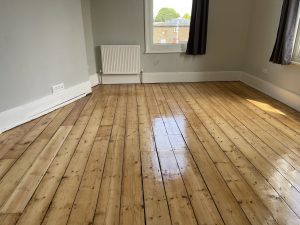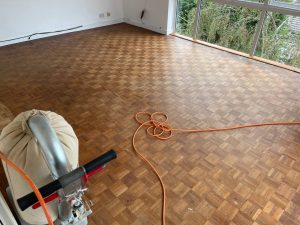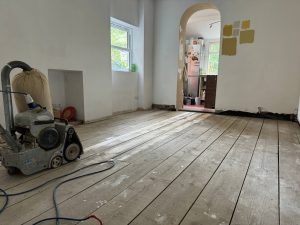The Role of Moisture Content in Floor Sanding

Achieving the Best Results for Your London Home
Introduction
When it comes to sanding wooden floors, understanding the role of moisture content is crucial. The moisture level in your wood can significantly impact the sanding process and the final finish. In this post, we’ll delve into the importance of moisture content in floor sanding and provide tips on how to manage it effectively in your London home.
Why Moisture Content Matters
Wood is a natural material that absorbs and releases moisture based on the surrounding environment. The moisture content of wood affects its size, shape, and structural integrity. When sanding and finishing wooden floors, controlling the moisture content is essential to prevent issues such as warping, cracking, or uneven finishes.
Ideal Moisture Levels for Sanding
For the best results, the moisture content of your wooden floors should be between 6% and 9% before sanding. This range ensures that the wood is stable and minimizes the risk of damage during and after the sanding process. Using a moisture meter, you can accurately measure the moisture content of your floors before beginning the project.
How to Measure Moisture Content
Measuring the moisture content of your wooden floors is a straightforward process with the right tools:
- Use a Moisture Meter: Purchase a reliable moisture meter designed for wood. These devices can be found at most hardware stores or online.
- Test Multiple Areas: Check the moisture content in several areas of the floor to get an accurate overall reading. This helps identify any variations that might affect the sanding process.
- Record the Readings: Document the moisture levels to ensure they are within the ideal range before starting your sanding project.
Managing Moisture Content
To achieve the ideal moisture content, follow these steps:
- Acclimate the Wood: Allow new wood flooring to acclimate in your home for at least a week before installation. This helps the wood adjust to the indoor humidity levels.
- Control Indoor Humidity: Maintain a consistent indoor humidity level between 30% and 50% using a humidifier or dehumidifier as needed. This prevents drastic changes in the wood’s moisture content.
- Address Moisture Issues: Fix any sources of excess moisture in your home, such as leaks or high humidity areas, to prevent the wood from absorbing too much moisture.
- Seasonal Adjustments: Be aware of seasonal changes that can affect indoor humidity and make necessary adjustments to maintain stable moisture levels in your wooden floors.
Impact on Sanding and Finishing
Proper moisture management is essential for achieving a smooth and durable finish. Here’s how moisture content impacts the sanding and finishing process:
- Sanding Quality: Wood with high moisture content can clog sanding belts and result in an uneven surface. Ensuring the wood is dry enough prevents these issues and leads to a smoother sanding process.
- Finish Adhesion: Finishes adhere better to wood with appropriate moisture levels. Excess moisture can cause finishes to bubble or peel, while too little moisture can make the wood overly absorbent.
- Long-Term Stability: Maintaining the correct moisture content helps preserve the wood’s stability, reducing the risk of future warping, cupping, or gaps in the flooring.







Hardwood vs. Engineered Wood: Which is Better for Sanding?
When it comes to choosing the right flooring for your home, understanding the differences between[Read more...]
How to Choose the Right Color Stain for Your Sanded Floors
How to Choose the Right Color Stain for Your Sanded Floors Enhance the Beauty[Read more...]
The Best Rugs and Mats for Protecting Sanded Floors
The Best Rugs and Mats for Protecting Sanded Floors Maintain your wooden floors with[Read more...]
Floor sanding and renovation and installation services in Bexley
Bexley: A Historic and Green London Borough Bexley is a charming borough located in the[Read more...]
The Importance of Ventilation During Floor Sanding
The Importance of Ventilation During Floor Sanding Expert Tips to Ensure a Safe and[Read more...]
Wood Floor Maintenance
[Read more...]
Top 10 Benefits of Professional Floor Sanding
If you’re a homeowner in London, you know how important it is to maintain the[Read more...]
The Role of Moisture Content in Floor Sanding
The Role of Moisture Content in Floor Sanding Achieving the[Read more...]
Floor Board Fitting
Installing, Fitting, sanding and finishing different types of flooring takes a lot of work. when[Read more...]
Sep
Floor sanding and renovation and installation services in Bromley
Bromley: A Blend of Suburban Comfort and Urban Convenience Bromley is a large and vibrant[Read more...]